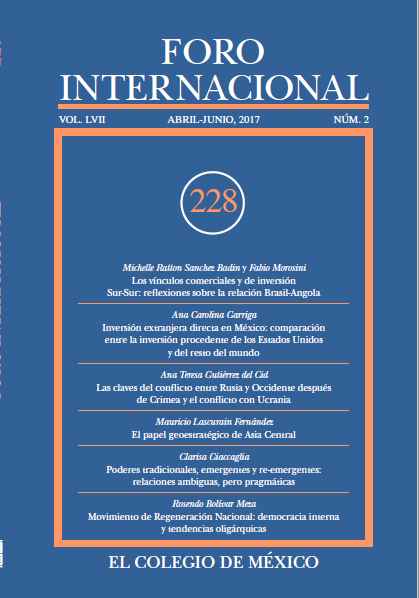El papel geoestratégico de Asia Central
DOI:
https://doi.org/10.24201/fi.v57i2.2431Palabras clave:
Asia Central, geopolítica, conflictos regionalesResumen
Uno de los acontecimientos geopolíticos más importantes de finales del siglo xx fue la aparición de cinco nuevos estados-nación, en lo que Halford Mackinder denominó, en 1904, como el pivote geográfico del mundo o heartland. Uzbekistán, Turkmenistán, Kazajstán, Tayikistán y Kirguizistán son los países que conforman Asia Central y en la actualidad desempeñan un papel relevante en la geopolítica y geoeconomía mundiales, principalmente por sus reservas de hidrocarburos. Sin embargo, por su importancia en la región, ésta se encuentra inmersa en diferentes conflictos, como procesos inconclusos de democratización, disputas por el uso y explotación de los recursos del Mar Caspio, problemas étnicos, un incremento del fundamentalismo islámico, los cuales alteran la estabilidad regional e internacional, a más de una intensa rivalidad de las potencias mundiales y regionales por influir en la zona. Este artículo identifica los conflictos más importantes en Asia Central y determina algunos de los posibles escenarios para el futuro de la región.Métricas
Citas
Akbarzadeh, S., “Keeping Central Asia stable”, Third World Quarterly, vol. 5, núm. 4, 2004, pp. 689-705.
Alonso, María Luciana, “Fundamentalismo Islámico en Asia Central: causas, actores y perspectivas de futuro”, Grupo de Estudios Internacionales Contemporáneos, AI 014/2011, Asia-Pacífico, 14 de julio de 2011, pp. 3-14.
“Asia Central”, monográfico de la Revista CIDOB d’Afers Internacionals, núms. 70-71, 2005.
Atal, Subodh “The New Great Game”, The National Interest, otoño 2005, pp. 101-105.
Barrera, E., La política exterior de los Estados Unidos en Asia Central: el caso de Uzbekistán, México, Escuela de Relaciones Internacionales, Universidad Anáhuac, 2006.
Beehner, Lionel, ASIA: U.S. Military Bases in Central Asia, Council on Foreign Relations background Q & A, 26 de julio, 2005, en http://www. cfr.org/russia-and-central-asia/asia-us-military-bases-central-asia/p8440#
Blank, Stephen J., “After Two Wars: Reflections on the American Strategic Revolution in Central Asia”, Conflict Studies Research Centre, Central Asia Series, 05/14, 2005.
BP, “Statistical Review of World Energy”, junio de 2014, en http://www.bp.com/content/dam/bp/pdf/Energy-economics/statistical-re-view-2014/BP-statistical-review-of-world-energy-2014-full-report.pdf
“Cuarta Cumbre del Caspio”, Kremlin, Astrakhan, 2014, en http://kre-mlin.ru/news/46686
Cutler, R. M., “Developments in the evolving Caspian legal regime: part 2-2”, FSU Oil & Gas Monitor, núm. 97, 2000, pp. 4-6, en http://www.gasandoil.com/goc/news/ntc03767.htm
De Pedro, Nicolás, “Terrorismo yihadista en Asia Central: ¿amenaza existencial o fantasma?”, Opinión CIDOB, núm. 362, octubre de 2015, pp. 1-3.
Dyner, Anna, Arkadiusz Legiec y Kacper Rekawek, “Ready to go? ISIS and its presumed expansion into Central Asia”, Policy Paper, núm. 19 (121), junio de 2015, pp. 1-16.
Djalili, M. R. y T. Keller, “Regímenes políticos de Asia Central: crisis de legitimidad, violencia política y perspectivas inciertas”, Revista CIDOB d’Afers Internacionals, núms. 70-71, 2005, pp. 35-68.
EIA: Energy Information Administration, Caspian Sea, Turkey, India, China, Central Asia, Washington, DC, Country Analysis Briefs, 2005.
______ , Overview of oil and natural gas in the Caspian Sea region, Caspian Sea series, 26 de agosto, 2013a.
______, Caspian countries are developing new oil and natural gas export capacity, 2013b, en http://www.eia.gov/todayinenergy/detail.cfm?id= 12 931
______ ,“China, international energy and data analysis”, 2015a, en https://www.eia.gov/beta/international/analysis.cfm?iso=CHN
______, “Turkey, international energy and data analysis”, 2015b, en https://www.eia.gov/beta/international/analysis.cfm?iso=TUR
______, Beta: International, Reserves and Capacity, Petroleum and Natural Gas, 2016, en http://www.eia.gov/beta/international/
Fairbanks, Charles, S. Frederick Starr, C. Richard Nelson y Kenneth Weisbrode,Strategic Assessment of Central Eurasia, Washington, DC, The Atlantic Council of the United States, 2001.
Hunter, Shireen T., Central Asia since independence, Londres, Preager Publishers, 1996.
IEEE: Instituto Español de Estudios Estratégicos, Panorama geopolítico de los Conflictos 2013, Ministerio de Defensa, 2013.
ICG: International Crisis Group, “Syria calling: Radicalisation in Central Asia”, Policy Briefing, enero de 2015, pp. 1-15.
IRIN: Integrated Regional Information Networks, “Kyrgyzstan: Poverty and migration in the Fergana Valley”, 2002, en http://www.irinnews.org/
Jones, R., “The politics of Central Asia and Caspian Energy”, Presentation at Chatham House, Londres, febrero de 2010, en http://www.iea.org/speech/2010/jones/chatham_house.pdf
Khamidov, Alisher, “Frustration builds among Uzbeks in southern Kyrgyzstan”, Eurasianet, 2001, en http://www.eurasianet.org/
Kovalskii, V. F., “Democratic Declarations and Political Realities”, en A. Vassiliev (ed.), Central Asia, Political and Economic Challenges in the Post-Soviet Era, Londres, Saqi Books, 2001.
Laherrere, J., “Forecasting future production from past discovery”, OPEC Semminar, septiembre 28-29, Viena, 2001.
Lapidus, Gail W., “Central Asia in Russian and American Foreign Policy after September 11, 2001”, Presentation from the panel discussion on Central Asia and Russia: “Responses to the War on Terrorism”, Berkeley, University of California, 2001.
Mackinder, H. J., “The Geographical Pivot of History”, The Geographical Journal, vol. 23, núm. 4, 1904, pp. 421-437.
Mahkamov, Anvar, “Tapping a New Way to Survive”, Transitions Online: Regional Intelligence, 2006, en http://www.tol.cz
Mañé, A., “Territorios ricos en hidrocarburos de Asia Central, ¿países productores, enclaves exportadores o países de tránsito?”, Revista CIDOB d’Afers Internacionals, núms. 70-71, 2005, pp. 87-113.
MAEC: Ministerio de Asuntos Exteriores y de Cooperación, “Turkmenistán, ficha país”, Gobierno de España, Oficina de Información Diplomática, 2013.
______ , “Tayikistán, ficha país”, Gobierno de España, Oficina de Información Diplomática, 2013.
MFA: Ministry of Foreign Affairs of the People’s Republic of China, “Shanghai Cooperation Organization”, 2004, en http://www.fmprc.gov.cn/eng/topics/sco/t57970.htm
Nalle, David, “Ferghana Report”, Central Asia Monitor, núm. 1, 2000, en http://www.friends-partners.org/lists/ferghana-valley/1999/0126.html
National Energy Policy Development Group, Reliable, Affordable, and Environmentally Sound Energy for America’s Future, Washington, DC, United States Government Printing, 2001.
Nichol, Jim, “Central Asia’s Security: Issues and Implications for U.S. Interests”, CRS Report for Congress, Washington, DC, U.S. Department of State, 2006.
ONU: Organización de las Naciones Unidas, Convención de las Naciones Unidas sobre el Derecho del Mar, 2006, en www.un.org/depts/los/conven-tion_agreements/texts/unclos/convemar_es.pdf
Pérez Martín, Miguel Ángel, “El status jurídico del Mar Caspio”, Geoeconomics and Geopolitics Journal, 1994.
Petrov, N. I., “Political Stability in the Conditions of the Command-Administrative Regime”, en A. Vassiliev (ed.), Central Asia, Political and Economic Challenges in the Post-Soviet Era, Londres, Saqi Books, 2001.
Roberts, J., “Caspian oil and Gas, How far have we come and where are we going?”, en Sally N. Cummings (ed.), Oil, Transition and Security in Central Asia, Londres, Routledge Curzon, 2003.
Roy, O., La nueva Asia Central o la fabricación de naciones, Madrid, Sequitur, 1997.
Rubin, Barnett R., “Central Asia Wars and Ethnic Conflicts, Rebuilding Failed States”, Human Development Report Office, United Nations Development Programme, 2004.
Rumer, Eugene, Richard Sokolsky y Paul Stronski, U.S. Policy toward Central Asia 3.0, Washington, DC, Carnegie Endowment for International Peace, Publication Department, 2016.
Sainz, Nora, “Asia Central en un mundo en cambio: de región periférica a área generadora de aplicaciones de políticas”, Revista CIDOB d’Afers Internacionals, núms. 70-71, 2005, pp. 115-141.
Swanström, Niklas, “Chinese Business Interests in Central Asia: A Quest for Dominance”, Central Asia-Caucasus Analyst, 18 de junio, 2003.
Tursunov, Bakhrom y Marina Pikulina, “Severe Lessons of Batken”, Conflict Studies Research Centre, UK Ministry of Defence, 1999, pp. 1-13.
UNEP: United Nations Environmental Programme, “Environment and Security, Transforming risk into Cooperation: Central Asia/Ferghana Osh/Khujand area”, United Nations Environmental Programme/United Nations Development Programme/Organization for Security and Cooperation in Europe/North Atlantic Treaty Organization, 2005.
UNODC: United Nations Office on Drugs and Crime, “Afganistán: UNODC advierte riesgo de que se convierta en «narco-Estado»”, Centro de noticias ONU online, 28 de junio de 2006.
______ , “Afghanistan Opium Survey”, Viena, 2013.
______, “Informe mundial sobre las drogas 2014”, Viena, 2014.U.S. Air Force, “Locations”, 2016, en https://www.airforce.com/lifestyle/location
USCB: U.S. Census Bureau, “U. S. International Trade in Goods and Services (FT900), Exhibit 17a- U.S. Imports of Crude Oil by Selected Countries”, 2016, https://www.census.gov/foreign-trade/PressRelease/current_press_release/index.html
Vassiliev, A., Central Asia, Political and Economic Challenges in the Post-Soviet Era, Londres, Saqi Books, 2001.
Wilches, Víctor, “Asia Central: Movimientos Islamistas”, 2009, en http://www.rebelion.org/docs/93602.pdf
Zapater Espí, Luis-Tomás, “El fundamentalismo islámico en Asia Central”, Cuadernos Const, de la Cátedra Fadrique Furió Ceriol, núms. 41/42, 2002-2003, pp. 181-197.












